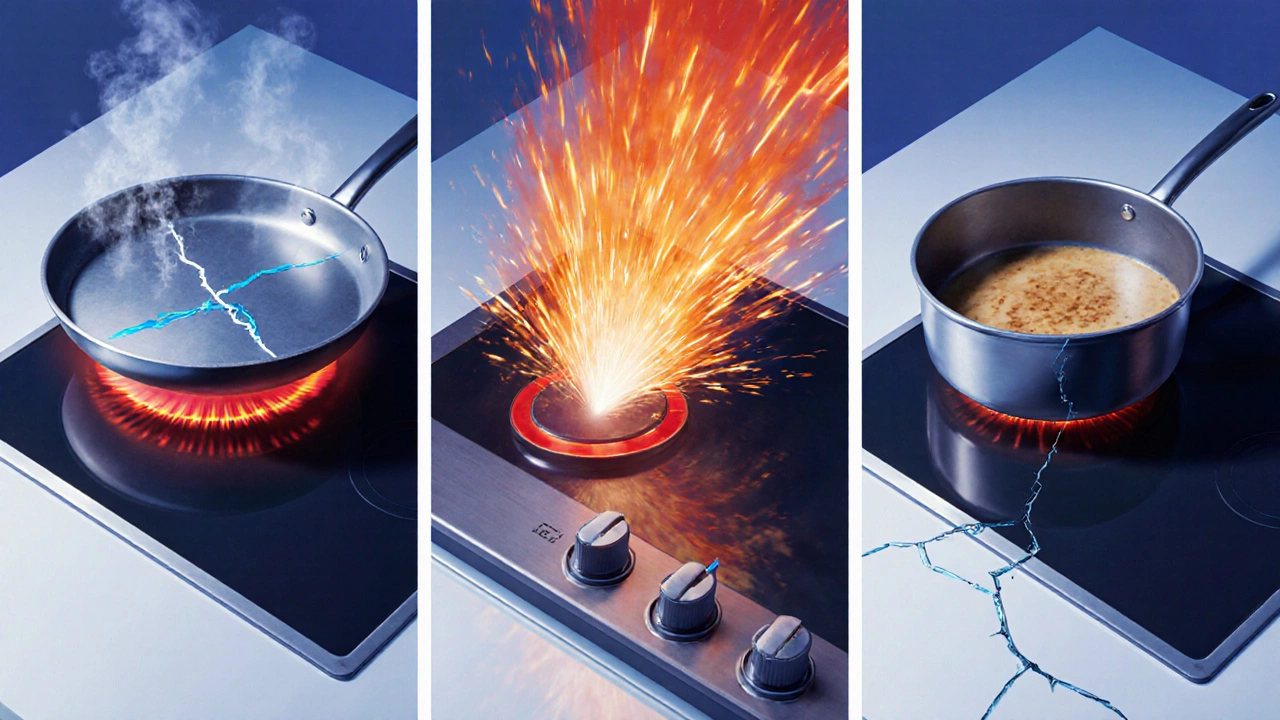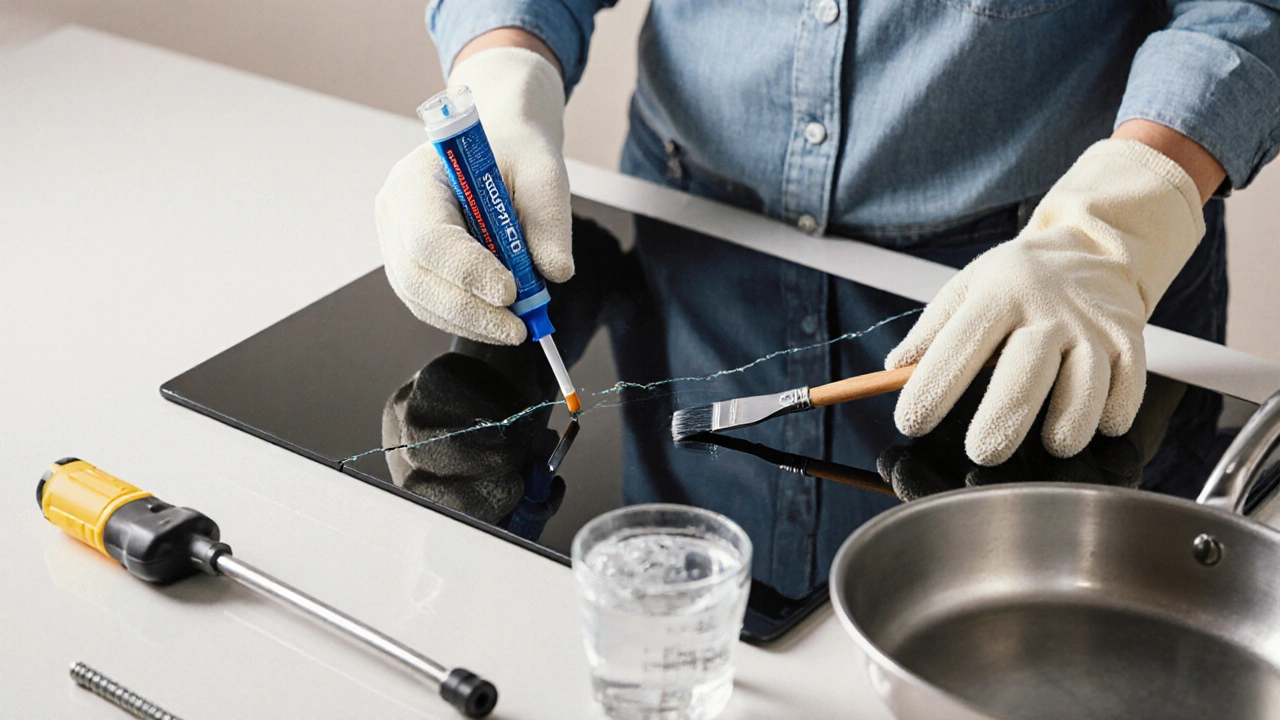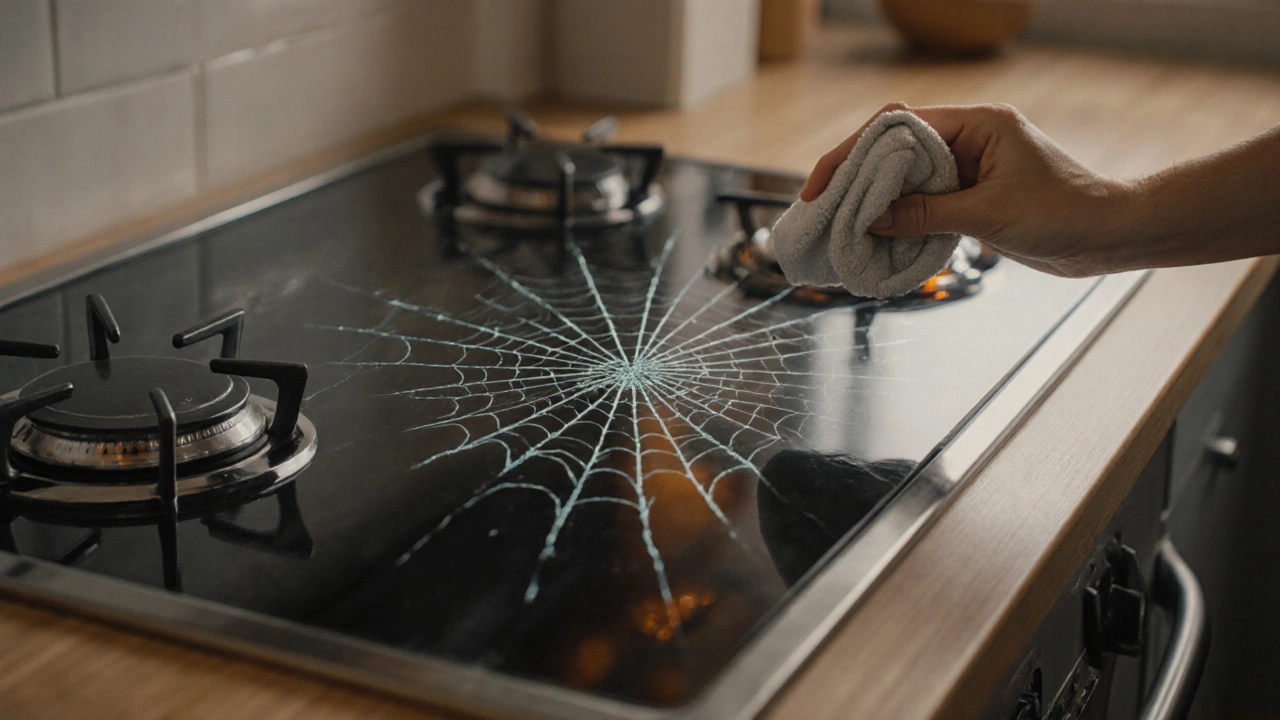When you glance at your kitchen and see a spider‑web pattern spreading across the cooking surface, the first thought is usually, "What went wrong?" That dreaded sight is a cracked electric hob, and it’s more than just an eyesore - it can affect heating performance and even become a safety hazard. Below we break down why an electric hob cracks, how to tell what’s happening, and which steps you can take yourself before calling a pro.
What an Electric Hob Actually Is
Electric Hob is a kitchen appliance that uses electric heating elements beneath a smooth glass‑ceramic surface to provide heat for cooking. The surface is typically made of a durable glass‑ceramic material that can withstand high temperatures, but it isn’t indestructible.
How the Glass‑Ceramic Surface Works
The cooking top you see is a sheet of Ceramic Glass Surface (often called glass‑ceramic). Beneath that sheet sit the heating components - either radiant coils for traditional electric hobs or an Induction Coil for induction models. A Thermostat monitors temperature and the control board regulates power. When everything runs smoothly, the heat transfers through the glass‑ceramic to your pan without any visible wear.
Top 7 Reasons an Electric Hob Cracks
Knowing the cause helps you prevent the next break. Here’s the most common culprits:
- Thermal Shock: Placing a cold pan on a hot surface (or vice‑versa) creates rapid temperature changes that the glass‑ceramic can’t absorb, leading to stress cracks.
- Power Surge: A sudden spike in voltage can overheat the heating element and the glass‑ceramic, creating micro‑fractures that spread.
- Impact Damage: Dropping cookware, a heavy pot, or even a kitchen utensil can chip the surface, which later expands into a full crack.
- Uneven Heating: Faulty wiring or a malfunctioning Thermostat can cause one section to overheat while the rest stays cool, stressing the material.
- Manufacturing Defects: In rare cases, a flaw in the Glass‑Ceramic Material goes unnoticed until the hob heats up and the weak spot gives way.
- Improper Cookware: Using warped or uneven-bottomed pans can concentrate heat in one spot, creating hot spots that crack the surface.
- Continuous Overheating: Leaving the hob on for too long, especially on high settings, can cause the glass‑ceramic to expand beyond its tolerance.
Spotting the Signs
Before the crack becomes obvious, you might notice subtle clues:
- Hissing or buzzing noises when the hob is on.
- Discoloration or a faint line before the crack spreads.
- Uneven heating - one area stays cool while others glow red.
- Visible hairline fractures when you look closely.

Diagnosing the Problem: Quick Checklist
| Cause | Symptom | Typical Fix |
|---|---|---|
| Thermal shock | Hairline crack after rapid temperature change | Replace glass‑ceramic top |
| Power surge | Sudden crack with scorch marks | Check circuit breaker, replace top |
| Impact damage | Chip that grows into crack | Professional replacement |
| Uneven heating | Hot spots, uneven glow | Inspect wiring & thermostat, replace faulty parts |
| Manufacturing defect | Crack appears early in life | Warranty claim or replace |
DIY Fixes - When It’s Safe to Try
Not every crack means you need a brand‑new hob. Small, isolated chips can be addressed with the right tools:
- Glass‑Ceramic Repair Kit: These kits include a clear epoxy designed for high‑temperature surfaces. Clean the area, apply the epoxy, and let it cure as per the instructions. It won’t restore original appearance but can stop the crack from spreading.
- Replacing the Surface: If your model allows it, you can order a replacement glass‑ceramic panel. Disconnect power, remove the screws holding the panel, and replace it. This is a moderate‑skill job - ensure the appliance is unplugged and follow the manufacturer’s service manual.
- Inspect Wiring: A quick visual check of the visible wiring (often under the control panel) can reveal burnt spots. If you spot damage, replace the wire or the entire control board.
When in doubt, stop. A compromised hob can lead to electric arcing or fire.
When to Call in a Professional
Call a qualified technician if you encounter any of these situations:
- The crack is larger than a few centimeters or runs across the cooking zone.
- You notice sparking, unusual smells, or the hob trips the circuit breaker.
- The appliance is under warranty - attempting a DIY fix could void it.
- You’re uncomfortable working with electrical components.
A professional will have the proper tools to replace the glass‑ceramic panel, test the heating elements, and ensure the unit meets safety standards.

Prevention Tips to Keep Your Hob Whole
Even the toughest glass‑ceramic can survive years with a bit of care:
- Avoid thermal shock: Let the hob cool before cleaning with cold water. Use room‑temperature water to wipe down a hot surface.
- Use appropriate cookware: Choose flat‑bottomed pans that match the hob’s size. Avoid warped bases that concentrate heat.
- Protect against impact: Lift heavy pots straight up, don’t slide them across the surface. Use protective pads when moving the hob.
- Install surge protection: A good quality surge protector can shield the appliance from voltage spikes.
- Don’t over‑heat: Follow the manufacturer’s recommended maximum cook time for high‑heat settings. Turn off the hob a few minutes before the dish is finished and finish cooking with residual heat.
- Regular maintenance: Clean spills promptly, check for loose screws, and inspect the control panel for any signs of wear.
Quick Maintenance Checklist
- Wipe the surface after each use with a soft, damp cloth.
- Inspect for chips or scratches weekly.
- Test each burner for even heating monthly.
- Run a brief power‑surge test with a surge protector annually.
- Schedule a professional inspection if the hob is over 7‑8 years old.
Frequently Asked Questions
Can a cracked electric hob still be used?
Small surface cracks may still allow the hob to heat, but they weaken the structure and can let moisture seep in, leading to electrical hazards. It’s safest to replace the cracked panel as soon as possible.
How much does a replacement glass‑ceramic panel cost?
Prices vary by brand and size, but most panels range from $120 to $300 NZD in 2025. Installation fees add another $80‑$150 if you hire a technician.
Will my warranty cover a cracked hob?
If the crack is due to a manufacturing defect and the hob is still within the warranty period, most manufacturers will replace the panel free of charge. Damage caused by misuse or accidental impact is generally excluded.
What’s the difference between a ceramic hob and an induction hob?
A ceramic (or glass‑ceramic) hob uses radiant electric coils beneath the surface to generate heat, while an induction hob creates a magnetic field that directly heats compatible cookware. Both use a glass‑ceramic top, but induction is generally faster and more energy‑efficient.
Can I repair a crack with household glue?
Regular household glues can’t withstand the high temperatures of a cooking surface. Use a high‑temperature epoxy specifically marketed for glass‑ceramic repairs, or replace the panel altogether.
Understanding why an electric hob cracks helps you act fast, keep your kitchen safe, and avoid costly replacements. The next time you spot a hairline fracture, you’ll know whether a quick epoxy fix will do, or if it’s time to call a professional for a full replacement.
